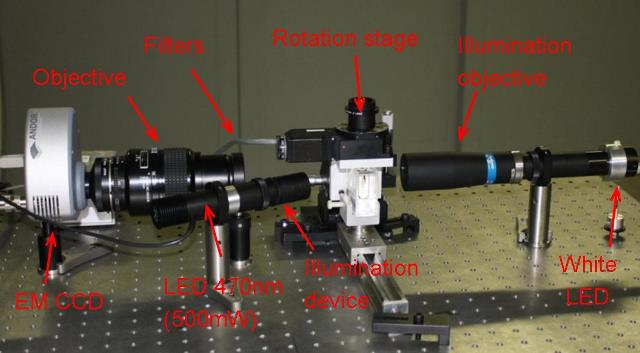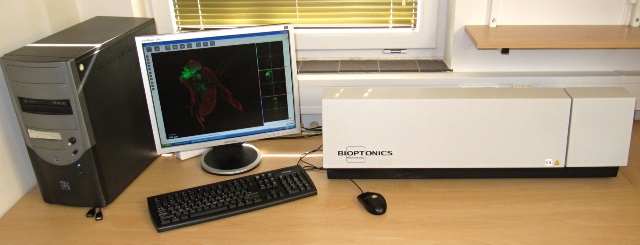OPT Scanner
Optical projection tomography scanners
Technology
Scanners are based on the principle of computed tomography, similarly like medical computed tomographs (CT). However, the biological specimens are illuminated by visible light, instead of X-ray. An inserted specimen is rotated gradually using a small angle step, e.g. 0.9°, in the scope of view of 360°; for each step an image of optical projection is acquired. From the full set of 400 projections resulting 3D data is calculated by a filtered back-projection algorithm (FBP). Thus, we get volume data of the specimen without necessity to cut it into physical slices.
Scanners
There are two scanners at the IPHYS Bioimaging Facility. First, it is commercial Bioptonics OPT 3001 Scanner. It has the possibility to adapt its field of view to the size of the specimen by zooming and, moreover, it uses high intensity of the excitation light, thus big and thick specimens can be scanned and visualized.
The second scanner, so called OPT Scanner Milano, was developed in cooperation with Technical University in Milano and was constructed from components available on the market. It uses high-quality telecentric optics, but without zoom, and a sensitive EMCCD camera providing us with sharp images of projections.
Technical parameters
The most suitable specimens for acquisition are the fixed ones that were made transparent by optical clearing, e.g., using protocols of BABB, CLARITY and CUBIC. The diameter of specimens can be in the range of 0.1-10mm. The specimens are glued to a metal holder by a super-glue, either directly or embedded in agarose. Small specimens MUST be embedded in agarose. The resolution of the scanners is from circa 20µm, for small specimens and 10x objective, isotropic along all axes (xyz). Projections are acquired either in transmission mode using white light or, in fluorescence mode, using monochromatic diodes and emission filters.
Bioptonics OPT 3001 Scanner
UV lamp is the source of excitation here.
1. GFP1, excitation 425/40 nm, emission from 475 nm (long pass – LP),
2. GFP+, excitation 470/40 nm, emission from 515 nm (LP),
3. Cy3, excitation 545/30 nm, emission 610/75 nm (band pass – BP),
4. Cy5, excitation 628/40 nm, emission 692/40 nm (BP).
OPT Scanner Milano
Monochromatic diodes are the source of excitation here.
1. GFP1, excitation 405/10 nm, emission 447/60 nm (BP) or emission from 450 nm (LP),
2. GFP+, excitation 472/30 nm, emission 520/35 nm (BP) or emission from 550 nm (LP),
3. Cy5, excitation 624/40 nm, emission 692/40 nm (BP).
Contact: RNDr. Barbora Radochová, Ph.D., tel. 2 9644 3769, email: Barbora.Radochova@fgu.cas.cz.


